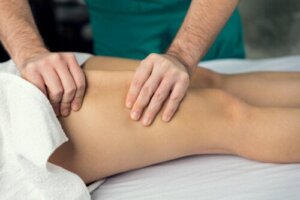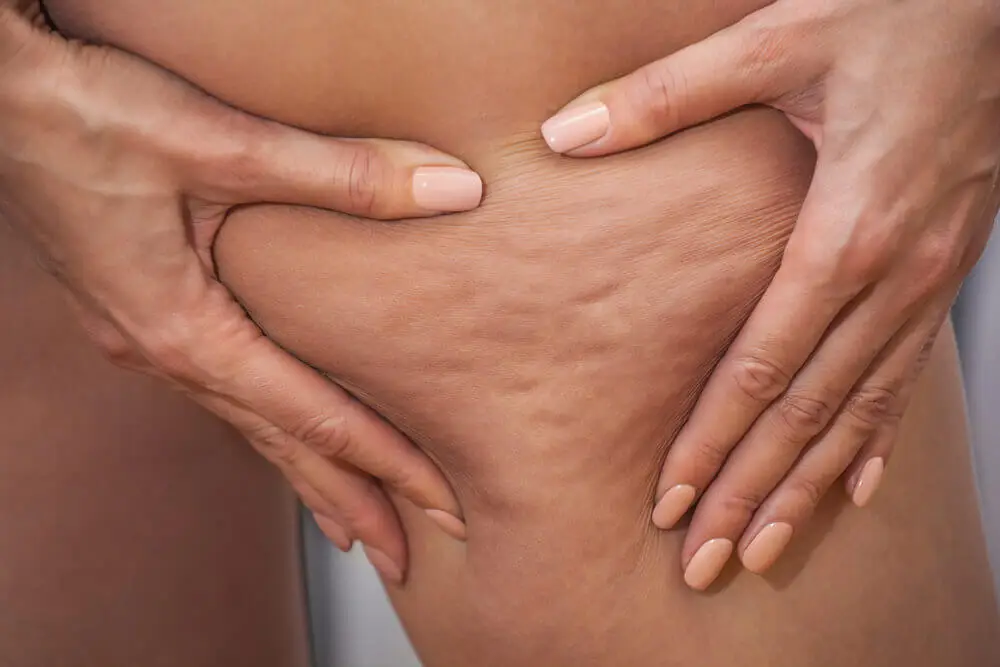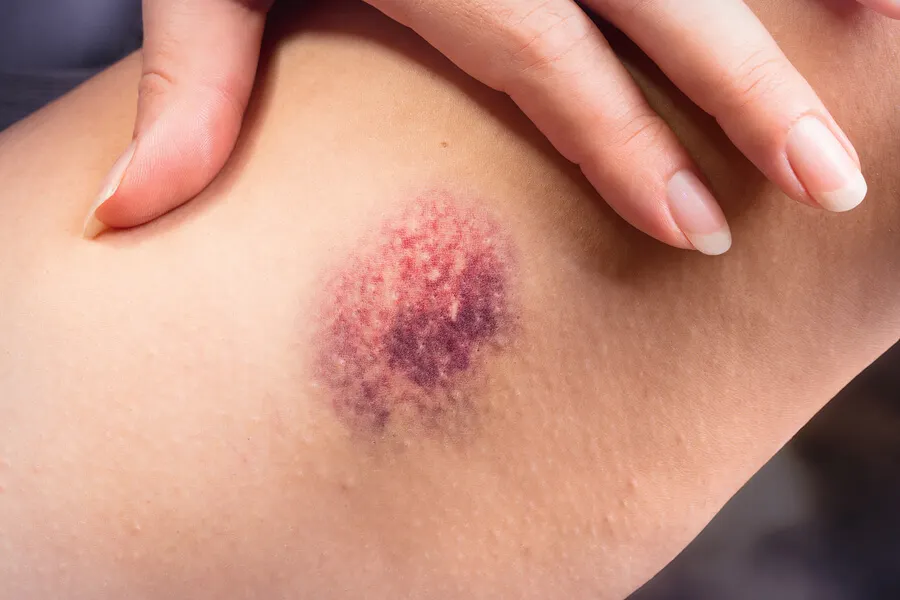Palper-rouler: What Is It and What Are Its Benefits?

Palper-rouler is a tissue massage technique. Its purpose is to promote lipolysis, helping in the elimination of fat by activating the lymphatic and venous circulation.
Thus, it’s a great ally in the arduous fight against cellulite, orange peel skin, and other similar problems. It can be performed by hand or using a device designed for this purpose.
It can also be complemented with other procedures to increase its effectiveness. So, in today’s article, we’ll learn all about the palper-rouler technique: what it consists of, how it’s done, its benefits, precautions and contraindications.
Cellulite: A difficult problem to treat
Its real name is edematous-fibro-sclerotic panniculopathy. This condition is caused by the accumulation of fat cells between the skin and the underlying muscle.
Hormonal factors are known to play a role, as well as age, genetics, being overweight, and living a sedentary lifestyle. In addition, it can be aggravated by poor venous and lymphatic circulation.
Cellulite is more common in women.
Cellulite is not a serious health problem, but it is from an aesthetic point of view, as it causes the appearance of bulges and irregularities (“orange peel skin”), particularly in areas such as the hips, thighs, and buttocks.
There are a wide variety of options to address the situation, from aesthetic procedures (mesotherapy, reducing massage, shock waves, cavitation, and radiofrequency) to natural treatments against cellulite, which include the use of apple cider vinegar, and coffee, among other products.

We think you may also enjoy reading this article: What is Hot Stone Massage and What Are the Benefits?
Palper-rouler: What it is and how it’s done
Palper-rouler is a technique that’s proposed as a solution to the problem of cellulite. It consists of a massage that reaches the deepest layer of the skin (hypodermis), where the fat cells are located.
Its objective is to help disintegrate the accumulations of adipocytes, stimulating blood and lymphatic circulation. In this way, by disintegrating it and reducing its size, it favors the elimination of cellulite.
The way to practice the paper-rouler consists of pinching and squeezing, as the word itself implies. It should be clarified that this term comes from French and can be translated as “palpate and roll.”
The idea is to pinch, squeezing the tissue between the thumb and the other fingers. The thumb exerts pressure on the skin from above, so that it helps to wrap the fold with the other fingers.
It’s suggested to apply the pressure from bottom to top and never in the opposite direction. In the same way, the area to be massaged should be moved upwards. In the abdominal area, it should be done carefully, making the movements from back to front.
There are devices in the form of rollers that make a suction or suction of the tissue, causing the fold to form. The advantage of the devices is that the person doing it gets less tired of repeating the same action.
To help in the process and facilitate the advance along the skin, oils are also applied, although it’s advisable not to overdo it, because then it would be too difficult to pinch.
As for the duration and frequency of this type of massage, it’s recommended to do it in sessions of at least 10 minutes. This type of massage can be applied every day, even up to two times on the same day. Although, if treated with a physiotherapist, once a week would be sufficient.
It’s important to note that once the treatment has been started, it should not be interrupted. Even if improvements are noted, fat accumulation may return.
We think you may be interested in reading this, too: The Benefits of Shiatsu Massage for Your Body
The benefits of palper-rouler massage
The results of a palper-rouler massage will vary depending on the degree of involvement of the area, as well as the dexterity of the pinching. However, at a rate of 2 to 3 sessions per week, in little more than a month, it’s very likely that you will notice a reduction in cellulite, as well as the appearance of orange peel skin.
In addition to these benefits, there are also other benefits to this method:
- It helps tone the skin
- It makes the skin more flexible
- Palper-rouler massage contributes to tissue oxygenation
- It helps to improve the functioning of the lymphatic system
- Using oils during massages nourishes the epidermis
- It reduces swelling and combats the feeling of heavy legs
However, it should be clarified that this technique is recommended for cellulite problems, not for overweight. However, it could help.
Tips and recommendations
The palper-rouler massage technique is considered a technique that helps in the treatment of cellulite, although it doesn’t work miracles by itself. In fact, what it does is enhance the results derived from maintaining a healthy lifestyle.
Therefore, it’s a tool that will work best when complemented with other strategies. This includes both regular physical activity and a balanced diet.
Also, for the effect to be greater and last longer, the following recommendations can be taken into account:
- After finishing the massage, rubbing with a horsehair glove will stimulate circulation while preventing the fat mass from settling again.
- It’s recommended to exfoliate the skin using coffee or some other natural product.
- The palper-rouler technique can also be combined with other techniques, such as vacumtherapy.
Finally, although this type of massage can be done on oneself, it’s always preferable to go to an experienced professional.
The possible side effects and contraindications
There are relatively few side effects of the palper-rouler. These include reddening of the skin, as well as a slight sensation of fairly mild pain.
As for contraindications, its application is not recommended in any of the following cases:
- People with psoriasis, eczema, or other skin problems
- Other circulatory problems, such as hemophilia or thrombosis
- Legs with poor venous circulation (the notorious “varicose veins”)
- When there are bruises or wounds

Is the palper rouler technique effective?
According to studies, this type of massage is an ancient, widely used, and effective practice. It’s suitable for the improvement of the appearance of scars, in terms of flexibility, inflammation, itching, or pain, as well as in the perception and tranquility of the patient.
As far as cellulite is concerned, in research carried out in France for more than two years and with more than 2500 patients, a treatment combining three actions (circulatory anti-edematous, lipolytic and defibrotic) was applied. In particular, additional procedures included palper-rouler massages while applying a caffeine cream.
The conclusions of the study state that this combination increases efficacy in the treatment of cellulite and can complement post-liposuction surgical techniques.
A problem that requires comprehensive attention
Cellulite is a problem that must be approached comprehensively, including a case-by-case analysis to determine the most appropriate treatment that guarantees optimal results. In this sense, the palper-rouler technique can be part of the solution, as it’s the ideal complement to a balanced diet and physical activity.
Although it may seem repetitive to say it, it must be emphasized that going to this or any other aesthetic procedure doesn’t exempt us from paying attention to various changes that we must undertake with respect to lifestyle if we want to improve this condition.
All cited sources were thoroughly reviewed by our team to ensure their quality, reliability, currency, and validity. The bibliography of this article was considered reliable and of academic or scientific accuracy.
- Bonnet, C, Perrin J. Mesodissolution and mesodrain, lepocyte lysis and drainage. Meta-analysis on 2 500 patients. Phlebologie – Annales Vasculaires. 2008; 61: 297-303.
- Frasson N, Valange-Comhaire M, Almeras I, et al. Cicatrice et massage. Revue Francophone de Cicatrisation. 2018; 2(3): 44-46.
- Khan M, et al. Treatment of cellulite: Part I. Pathophysiology. Journal of the American Academy of Dermatology. 2010; doi:10.1016/j.jaad.2009.10.042.
- Mole B, Blanchemaison P, Elia D, et al. L’ultrasonographie à haute fréquence et le celluscore : un progrès dans l’évaluation objective du phénomène de cellulite. Annales de Chirurgie Plastique Esthétique. 2004; 49(4): 387-395.
- Rulleau T, Rivette C, Toussaint L. El masaje, una técnica basada en la evidencia. EMC – Kinesiterapia – Medicina Física. 2017; 38(3): 1-8.
- Schavelzon D, Blugerman G, Taboada F, et al. Results of the application of ELOS system (Radio frequency + Light) in cellulitis. Dermatología Cosmética, Médica y Quirúrgica. 2007; 5(1):53-59.
- Vázquez Gallego J. Manual profesional del masaje. Badalona: Paidotribo, 2009.
This text is provided for informational purposes only and does not replace consultation with a professional. If in doubt, consult your specialist.








